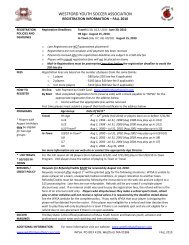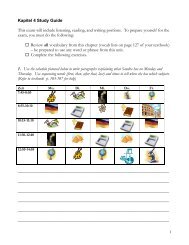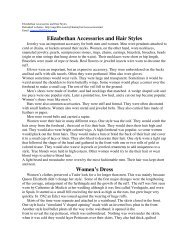WPS Protocol for head lice - Westford Public Schools
WPS Protocol for head lice - Westford Public Schools
WPS Protocol for head lice - Westford Public Schools
Create successful ePaper yourself
Turn your PDF publications into a flip-book with our unique Google optimized e-Paper software.
<strong>WPS</strong> <strong>Protocol</strong> <strong>for</strong><strong>head</strong> <strong>lice</strong>:1. If you suspect your childhas <strong>head</strong> <strong>lice</strong>, pleasecontact your child’shealth care providerregarding appropriatetreatment.2. Contact your child’sschool nurse if your childis diagnosed as having<strong>head</strong> <strong>lice</strong>.3. If <strong>head</strong> <strong>lice</strong> arediagnosed, do not allowyour child to return toschool until the morningafter the first treatment,nit removal, and cleaningof personal items. Youmust accompany yourchild to the clinic uponreentry into school.Your child may return toclass only if he/she isnit-free. The schoolnurse will also recheckyour child 7-10 daysafter treatment.Continue to check yourchild’s hair daily <strong>for</strong> 10-14 days after treatmentand regularly thereafter.4. Please rein<strong>for</strong>ce withyour child theimportance of notsharing hats, scarves,coats, and personalitems (especiallybrushes, combs and hairornaments).Illustration of egg on ahair shaft (CDC photo)-----------------------Nymph <strong>for</strong>m(CDC photo)
------------------------Adult louse (CDCphoto)West<strong>for</strong>d<strong>Public</strong><strong>Schools</strong>Shaping the future onechild at a timeHead LiceWho is at risk <strong>for</strong> getting<strong>head</strong> <strong>lice</strong>?“Head <strong>lice</strong> are foundworldwide. In the UnitedStates, infestation with <strong>head</strong><strong>lice</strong> is most common amongpreschool children attendingchild care, elementaryschool children, and thehousehold members ofinfested children. Althoughreliable data on how manypeople in the United Statesget <strong>head</strong> <strong>lice</strong> each year arenot available, an estimated6 million to 12 millioninfestations occur each yearin the United States amongchildren 3 to 11 years ofage”.-CDC (Centers <strong>for</strong> DiseaseControl and Prevention)Facts about <strong>head</strong> <strong>lice</strong>** Nits (the eggs of the <strong>head</strong> louse)are small yellowish-white, ovalshapedeggs that are “glued to theside of a hair shaft” at an angle.* Nits must be laid by live <strong>lice</strong>.You cannot “catch nits.”* Once laid, it takes 7-10 days <strong>for</strong>a nit to hatch, and another 7-10days <strong>for</strong> the female to mature andbegin laying her own eggs.* Head <strong>lice</strong> are clear in color whenhatched, and then quickly developa reddish-brown color afterfeeding,* Head <strong>lice</strong> are about the size ofsesame seeds.* Head <strong>lice</strong> have six legs equippedwith claws to grasp the hair.* Head <strong>lice</strong> are crawling insects.They cannot hop, jump, or fly.* Head <strong>lice</strong> do not thrive on pets.*Head <strong>lice</strong> are small, winglessinsects that feed on human blood.They need human blood in order tosurvive.
* Head <strong>lice</strong> live <strong>for</strong> approximately30 days on a host and a femalelouse may lay up to 100 nits(eggs).* Head <strong>lice</strong> off of their humanhosts will starve. The NPAsuggests that, in most cases, a<strong>head</strong> louse will not survive <strong>for</strong>more than 24 hours off of itshuman host.10 Steps to Help Keep HeadLice and Their Eggs Out ofYour Child’s Hair*1. Watch <strong>for</strong> signs of <strong>head</strong> <strong>lice</strong>,such as frequent <strong>head</strong> scratching.Anyone can get <strong>head</strong> <strong>lice</strong>…mainlyby <strong>head</strong> to <strong>head</strong> contact but alsofrom sharing hats, brushes and<strong>head</strong>rests. Lice do not jump or fly.2. Check all family members <strong>for</strong><strong>lice</strong> and nits (<strong>lice</strong> eggs) at leastonce a week. Only those infestedshould be treated. Lice arereddish-brown wingless insects;nits are grayish-white, always ovalshaped, and are glued at an angleto the side of the hair shaft.3. Be sure not to confuse nits withhair debris such as bright whiteirregularly-shaped clumps ofdandruff stuck to the hair shaft orelongated segments of dandruffencircling the hair shaft and easilydislodged. Lice treatment is notappropriate <strong>for</strong> hair debris.4.Consult your pharmacist orphysician be<strong>for</strong>e applying or using<strong>lice</strong> treatment pesticides when theperson involved is pregnant,nursing, has allergies, asthma,epilepsy, other pre-existingmedical conditions, or has <strong>lice</strong> ornits in the eyebrows or eyelashes.Never use a pesticide on or nearthe eyes.5. Remember, all <strong>lice</strong>-killingproducts are pesticides. If youchoose to purchase an over-thecountertreatment, follow thedirections carefully and use withcaution. The NPA stronglydiscourages prescriptiontreatments containing lindane.Based on increasing reports ofpossible insect resistance on anational level, the NPA advisesparents to discontinue their use atthe earliest sign of treatmentfailure. MANUAL REMOVAL IS THEBEST OPTION WHENEVERPOSSIBLE AND ESPECIALLY WHENTREATMENT PRODUCTS HAVEFAILED.6. Follow package directionscarefully. Use the product overthe sink, not in the tub or shower.Always keep the eyes covered.7. Remove all nits. This assurestotal <strong>lice</strong> treatment. Separate hairin sections and remove allattached nits with a <strong>lice</strong> comb,baby safety scissors, or yourfingernails.8. Wash bedding and recentlyworn clothing in hot water and dryin a hot dryer. Combs and brushesmay be soaked in hot water (notboiling) <strong>for</strong> 10 minutes.9. Avoid <strong>lice</strong> sprays! Vacuuming isthe safest and best way to remove<strong>lice</strong> or fallen hairs with attachednits from upholstered furniture,rugs, stuffed animals and carseats.10. Notify your child’s school,camp, child care provider andneighborhood parents. Check <strong>for</strong><strong>lice</strong> on a regular basis. This is thebest way to protect your familyand community.Source: National PediculosisAssociationFor additional in<strong>for</strong>mation contactyour school nurse or the HealthDepartment at 978-692-5509.
1/2010 jmc






